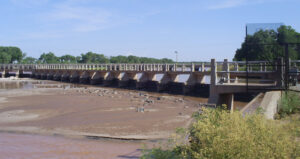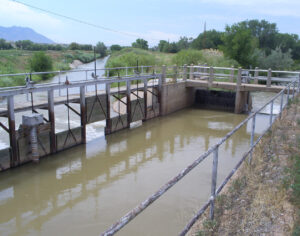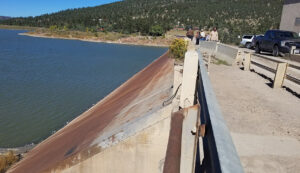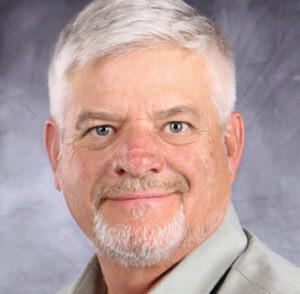The Middle Rio Grande Conservancy District (MRGCD), headquartered in Albuquerque, New Mexico, offers irrigation, drainage, flood control, and responsible water conservation services to irrigators and farmers in the middle agricultural region of the state. In this interview, MRGCD CEO and Chief Engineer Mike Hamman speaks with Irrigation Leader about the district’s history, the drought conditions confronting it today, and the steps it is taking to continue successfully fulfilling its mission.
Irrigation Leader: Tell us about your background and how you came to be in your current position.
Mike Hamman: I have been in the water resources management for more than 36 years. Prior to graduating from the civil engineering program at the University of New Mexico, I was an intern with the City of Albuquerque, working on water supply and water resource issues. After college, I started working with the Bureau of Reclamation in Utah. My work there focused on the Central Utah Project as well as various smaller facilities and canals, and in some cases, resource management areas with dam construction. I was in a rotation program that allowed employees to experience all aspects of the agency’s work.

Eventually, I ended up on a 9‑month construction project in Wyoming at Fontenelle and Big Sandy Dams. Through that, I got good, foundational experience in large water resource projects. I also worked in southern New Mexico on the Bradley Dam Project, and then moved into water resources management, doing operations and maintenance for 11 Reclamation projects in the Rio Grande basin, from southern Colorado to Fort Quitman, Texas. My area of expertise evolved into water accounting, water operations, and water management requiring multiagency coordination.
I took an early-out departure offer from federal service during the Clinton administration and went to work for the City of Santa Fe and later the Jicarilla Apache Nation. This turned out to be great experience and helped me see things from perspectives other than federal optics. Thereafter, I rejoined Reclamation, focusing on tribal water issues and municipal water management issues. I was the manager of the Albuquerque Area Office for 6 years. At that point, I retired from federal service and joined the MRGCD as its CEO and chief engineer. That is where I’ve been for the past 6 years.
Irrigation Leader: Please tell us about the MRGCD.
Mike Hamman: In the late 1800s and early 1900s, there was tremendous water development in the upper Rio Grande basin in Colorado that affected water availability in communities in New Mexico and West Texas. Simultaneously, the region experienced a series of large flooding events. These circumstances proved overwhelming for the 78 separate ditch companies operating in this region. In response, the State of New Mexico enacted the legislation that formed the MRGCD in 1922.
The new district took on several issues, including flood control, drainage concerns, and irrigation distribution systems. In the course of doing so, it took all existing water-related systems and combined them into four separate diversion dams. It combined the drainage and diversion systems in an effort to reclaim land that had gone out of production. The original target of reclaiming around 124,000 acres was never achieved. The maximum reclaimed acreage was in the 95,000‑acre range in the 1960s, and urbanization and other factors that have occurred since then has reduced irrigated lands to about 60,000 acres in our service area today. We also manage the Rio Grande bosque lands, which comprise about 30,000 acres of land between the levees along the river channel.
Irrigation Leader: Where does your water comes from, and what kind of storage and delivery infrastructure do you have?

Mike Hamman: As the district developed, it built a reservoir on the Rio Chama, which is a major tributary of the Rio Grande, just south of the Colorado border near the town of Chama, New Mexico. It is the only storage reservoir of native storage water rights that the district owns. It’s 150 miles north of Albuquerque and is a supplemental supply providing critical releases for late-season irrigation needs and baseflows for environmental purposes. We primarily survive on the run of the river out of the main stem of the Rio Grande. The district has a 20,900-acre-foot Reclamation contract out of the San Juan–Chama Project that has provided additional water security to the region. Because our main source of water is the runoff and base flows of the main stem, we are subject to swings in snowmelt and runoff availability. Typically, we have full use of El Vado Reservoir, but El Vado was constructed after the Rio Grande Compact was enacted, so our ability to store water in and release water from it is governed by the compact, meaning that storage can be limited or completely restricted under specific conditions.
Irrigation Leader: How is your water supply being affected by drought, changes in snowpack and river flow, and other climatic issues?
Mike Hamman: The cycle of the last 3 years is an example of what we’ve historically dealt with. In the 1950s and 1960s, the basin experienced some difficult drought cycles. During that period, there was no San Juan–Chama water available to the district, as that project was not put into production until the 1970s. The Rio Grande Compact had already been ratified by the states and the U.S. Congress and implemented in 1938. The compact protects lower basin water users, primarily those who rely on Elephant Butte Dam and Reservoir. There are schedules of water that must be delivered by Colorado to New Mexico and by New Mexico to Texas (technically, to the lower Rio Grande below Elephant Butte).
There’s a Reclamation project that governs where that water must be delivered to water users below Elephant Butte Dam, including a treaty with Mexico. New Mexico has a schedule based on native flows coming into the middle of the Rio Grande. A certain percentage has to be delivered to Elephant Butte. In some cases, like in a high-water-year period, after you pass an index amount of about a million acre-feet, 100 percent of the additional water must be delivered on to Elephant Butte in a natural river system that consumes a significant amount in late summer.
In 2018, there was a historically low runoff, but the district retained carryover storage from the previous year and was not restricted at all by the compact, so there was free use of the reservoir at the beginning of 2018. We also had 2 years’ worth of contract supply out of the San Juan–Chama Project that we had been able to bank the previous year. With this available storage, a full irrigation season was provided, although the season ended with minimal carryover storage.
In 2019, there was a big runoff—150 percent of the average—but an equally large compact delivery requirement. Typically, if we do not also receive monsoon rain, fulfilling a compact delivery through the 150 miles of river that go through the Middle Valley is extremely difficult. This is because infiltration and evapotranspiration on the river causes half or more of the valley depletions, leaving less than half available for agriculture. All combined, the depletions allowed for under the compact and factored into the delivery tables amount to around 400,000 acre-feet a year. The district released all its carryover storage in December to try to meet compact deliveries, but still came up short by about 38,000 acre-feet.

In 2020, we had decent snowpack at the start of the season, so we expected normal runoff, but runoff tanked from April onward because we received little precipitation and were experiencing higher temperatures. The watershed was in bad shape, as there were no precipitation events to keep up soil moisture during the previous fall and summer. If you start the season with poor soil moisture and a thirsty watershed, quite a bit of runoff is required to address the watershed deficit before you have water that is available to store and divert.
In 2020, we did have storable water, but because of compact rules, the 2019 debit water had to be stored and retained first, and the U.S. Department of the Interior stores water to protect the Pueblos’ water rights. That left only a small bit available for general irrigation use, as the runoff was tanking and we were only able to store about 14,000 acre-feet. By mid-July, all available storage for general use was exhausted.
It was a pretty tough situation for our farmers. We went to the Rio Grande Compact commissioner for New Mexico and made a request under article VI of the compact, which allows a state to request the use of debit storage water. The compact commissioner took the request forward, and all three states approved the use of the stored water for debit purposes for use both by irrigators and for important fish habitat. The district strictly managed this volume, and our operational constraints caused hardship and shortages in certain parts of the district but averted a total collapse of the system.
Because of the poor seasonal monsoon, we weren’t able to make any headway against the compact debit. In fact, our debit increased to about 96,000 acre-feet. Even though the snowpack is near normal right now, the National Weather Service’s predictions for spring and early summer 2021 are not looking good in terms of temperatures and precipitation.
Irrigation Leader: When was the Rio Grande Compact signed, and who are the parties to it?
Mike Hamman: The Rio Grande Compact was agreed to in 1926 and ratified in 1938. The parties to the compact are the states of Colorado, New Mexico, and Texas. The United States appoints a nonvoting chair of the commission. Colorado’s San Luis Valley encompasses the upper Rio Grande basin, where the headwaters are located. There is a delivery point at the border of Colorado and New Mexico called the Lobatos Gauge. New Mexico’s water use is focused on the Middle Rio Grande, from the Cochiti Dam down to Elephant Butte. For the purposes of the compact, Texas includes southern New Mexico as well as the area from El Paso, Texas, down to Fort Quitman, Texas. By treaty convention, the Republic of Mexico also receives an allocation out of Elephant Butte for its needs.
Irrigation Leader: Have the drought conditions of past years gotten to the point where they have affected your deliveries?
Mike Hamman: The Conservancy Act allows the district to manage available supplies under the concept of shared shortages even though we’re in a prior-appropriation-doctrine state. It recognized that this valley inherited prehistoric Pueblo water use as well as laws in existence under the Treaty of Guadalupe Hidalgo. The Conservancy Act also recognizes that this is not an adjudicated basin.
Eighty percent of the crops grown here are alfalfa based, meaning they are more resilient in a shared-shortage situation. Alfalfa crops also make small and one-person farming operations feasible. The larger farms are split up through inheritances, but some farms have gotten larger due to acquisitions and leasing. The average farm is in the 20‑acre range, and there are around 200 farms that are 200 acres in size or larger.
If there are shortages, we share them by lengthening the time between irrigations. Typically, an alfalfa farmer irrigates every 2–3 weeks, but during shortages, that period is extended to 4 weeks or more. The district works to prioritize scheduling to water crops that need more frequent irrigation, but geographic location creates operational logistics in a long and narrow delivery area. Our Drought Contingency Plan has identified the need for several reregulation reservoirs to help smooth out this problem, and we are moving forward with land acquisitions and applying for funding to help build this infrastructure.
The district has created a water bank program that provides for farmers who have sold off their senior water rights to continue to irrigate higher-quality lands when the district has surplus water and have thereby become junior to all other users. These supplies can be and have been curtailed. Last year was the first year that farms were curtailed in May. Over the past 20 years or so, the water bank has only been curtailed a couple of times, including in 2018 and 2020, and it is anticipated that no water bank lands will receive water in 2021.
Irrigation Leader: Have the agricultural users in your area taken steps to reduce their water use or increase their efficiency in reaction to these drought situations?
Mike Hamman: In 1997, the district passed a water distribution policy that addresses efficiency. The guiding principle is that each farm must be in a condition such that the delivery rate is 1 acre per hour or better. In a normal year, we struggle to push water down to many farmers, particularly those at the far southern end of the district. The larger farmers typically have made improvements, but there’s a block of farmers who are not in a position to reinvest in leveling and making delivery ditch improvements. Those who grow alfalfa on 10–60 acres are receiving only supplemental income from farming and are not anxious to make these investments without some assistance, so we are helping with planning and engineering resources so that they can apply to the Environmental Quality Incentives Program (EQIP) or other programs that address water efficiency problems.
The district is taking a carrot-and-stick approach. We’re providing resources and are encouraging grants, and we will supplement them with our resources. We have loan programs, and we’re making the necessary improvements on our system to assure proper delivery capacity. This generation of farmers hasn’t experienced many shortages. Conditions will hopefully encourage people to move more rapidly in that direction.
The district is applying for a Resource Conservation Partnership Program grant that will allow us to step in the shoes of the Natural Resources Conservation Service to put EQIP on steroids and address some other resource issues. There are three refuges that receive water from our system that need attention, and we also need to get farmers more actively involved in making improvements to avoid the risk of getting restricted deliveries.
Irrigation Leader: What effects is urbanization having on your district?
Mike Hamman: We work closely with the larger urban areas. The City of Albuquerque has formed a regional water utility authority, the Albuquerque–Bernalillo County Water Utility Authority (ABCWUA). It has made significant changes, moving from a primarily groundwater pumping supply and making major investments in a surface water diversion and return flow system. Together, the MRGCD and the ABCWUA have two-thirds of the water allocation from the San Juan–Chama project; that is a major source of its surface water supplies.
We are concerned about the loss of streamflow. From the turn of the 20th century to the early 1950s or so, this used to be a gaining reach, and it became a losing reach because of groundwater pumping. Municipalities are junior water users, so the state requires them to offset their effects on the senior users (irrigators and the compact), but they are protected from shortages since, unlike most farmers, they can convert to groundwater.
We’re also concerned about the continued loss of water rights off agricultural land. The prices of water rights are attractive, so urban interests are required to buy and dry farmland to offset the effects of their pumping on the Middle Valley. That puts numerous acres of farmland out of production, and many speculators are actively purchasing lands for water rights and housing developments on prime farm ground. It’s a big concern for the future of the district, but it is difficult to challenge private property rights. We are trying to convince all regional water interests to develop a sustainable water plan in order to preserve the agricultural lifestyle in this area.
Irrigation Leader: Is there anything else you wanted to touch on that we haven’t discussed yet?
Mike Hamman: We serve six Pueblo communities under federal statutes. Those statutes require a certain service level for the Pueblo agricultural lands, because the Pueblos provided rights of way for waterways and drains to be constructed through their lands. They’re an important constituent, and their lands are not being developed much from an agricultural standpoint. They could be a prominent piece of the puzzle down the road if urbanization consumes a lot more of the nonfederal irrigable lands.
Irrigation Leader: What is your vision for the future of the district, particularly when it comes to addressing the issues of drought on the Rio Grande?
Mike Hamman: We’re participating as a lead agency with Reclamation on the Rio Grande Basin Study, which was authorized several years ago by the Secure Water Act. A lot of the authorities for the federal projects, both of Reclamation and of the U.S. Army Corps of Engineers, are outdated and prohibit needed flexibility in operations.
We have one main stem reservoir, Cochiti Dam, which is right at the top of our area. If we have the ability to regulate irrigation and other water supplies at that location, we could do a lot better with some of our endangered species flow needs, could manage irrigation water more efficiently, and could perhaps handle compact deliveries more efficiently. We have facilities and infrastructure that we need to reevaluate in light of the new hydrographs we are experiencing. There has been quite a change in the way the snow melt runoff is occurring. It’s occurring at higher peaks and over shorter durations because of temperature changes. We want to look at our infrastructure to see if we can make it more reactive so that we can better manage the hydrograph for more storage or efficient transport.
We also have plans to move forward with on-farm efficiency and system efficiency work. We’re seeking federal grants and other resources to make our system more resilient.
Fallowing programs also help us get through years of tighter supply; we can then revert land back to farming when we have more water available.
Those are all programs we’re working on, and it’s going to take the full efforts of the MRGCD, the State of New Mexico, and the federal agencies to make them happen in the time period in which we need them to occur. Climate change seems to be happening faster than the models are predicting, so we have to move forward expeditiously.
Mike Hamman is the CEO and chief engineer of the Middle Rio Grande Conservancy District, located in Albuquerque, New Mexico. He can be reached at mikeh@mrgcd.us.

